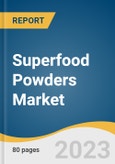The global superfood powders market size is expected to reach USD 11.50 billion by 2030, registering a CAGR of 7.2% during the forecast period. The market has witnessed rapid growth in recent years and has caught consumers’ attention owing to the increasing prevalence of obesity and diabetes and consumers opting for healthy diets. Growing consumer need for antioxidants, phytochemicals, vitamins, and minerals has increased the popularity of superfood powders in past years. The product has grown into a commercial product in the U. S. and several companies are investing in superfood powders.
Some of the popular superfoods are salmon, kale, açai berries, kefir, and almonds. When incorporated into a well-balanced diet, superfoods can promote heart health and weight loss, improve energy levels, and even reduce the effects of aging. Thus, consumers are looking for convenient ways to add these superfoods to their diet, which is driving the demand for powders.
In response to the increase in the frequency of diet-related diseases such as diabetes, obesity, or cancer, the search for healthy diets has led to a surge in the demand for functional foods with multiple benefits, among which are superfoods. Many countries globally have witnessed a shift in the preference for functional foods as the trade of superfoods has increased over the past decade.
The organic product segment is expected to witness lucrative growth over the forecast period. Organic foods have been gaining traction among consumers as people are becoming aware of the associated benefits and long-term impact on their health. Many superfood brands have been targeting consumers by labeling their products as “organic” and made with “natural ingredients”. Additionally, due to the COVID-19 pandemic, consumers globally are concerned about their eating habits and are seeking healthier options in their daily diet.
The offline distribution channel segment held the largest revenue share in 2022. Superfoods are being increasingly sold through hypermarkets, supermarkets, convenience stores, and pharmacies. A large number of consumers prefer buying food products from offline stores due to the shopping experience of these stores. Brick-and-mortar specialty stores are among the major distributors of these products. The market is characterized by the presence of a few well-established players and several small- and medium-sized players with a strong presence across the globe. Leading manufacturers hold a significant market share in North America.
Some of the popular superfoods are salmon, kale, açai berries, kefir, and almonds. When incorporated into a well-balanced diet, superfoods can promote heart health and weight loss, improve energy levels, and even reduce the effects of aging. Thus, consumers are looking for convenient ways to add these superfoods to their diet, which is driving the demand for powders.
In response to the increase in the frequency of diet-related diseases such as diabetes, obesity, or cancer, the search for healthy diets has led to a surge in the demand for functional foods with multiple benefits, among which are superfoods. Many countries globally have witnessed a shift in the preference for functional foods as the trade of superfoods has increased over the past decade.
The organic product segment is expected to witness lucrative growth over the forecast period. Organic foods have been gaining traction among consumers as people are becoming aware of the associated benefits and long-term impact on their health. Many superfood brands have been targeting consumers by labeling their products as “organic” and made with “natural ingredients”. Additionally, due to the COVID-19 pandemic, consumers globally are concerned about their eating habits and are seeking healthier options in their daily diet.
The offline distribution channel segment held the largest revenue share in 2022. Superfoods are being increasingly sold through hypermarkets, supermarkets, convenience stores, and pharmacies. A large number of consumers prefer buying food products from offline stores due to the shopping experience of these stores. Brick-and-mortar specialty stores are among the major distributors of these products. The market is characterized by the presence of a few well-established players and several small- and medium-sized players with a strong presence across the globe. Leading manufacturers hold a significant market share in North America.
Superfood Powders Market Report Highlights
- North America held the largest revenue share in 2022 as consumers are consuming superfood powders in order to boost immunity, prevent diseases, and complete their daily intake of important micronutrients
- The organic product segment is expected to expand at the fastest CAGR over the forecast period. Organic foods have been gaining traction among consumers as people are becoming aware of the associated benefits and long-term impact on their health
- The online distribution channel segment is expected to expand at the fastest CAGR from 2023 to 2030. Driven by pandemic-led facts and figures, manufacturers of superfood powders switched to online platforms to reach more consumers and offer better-quality products.
Table of Contents
Chapter 1. Methodology and Scope
Chapter 2. Executive Summary
Chapter 3. Superfood Powders Market Variables, Trends & Scope
Chapter 4. Consumer Behavior Analysis
Chapter 5. Superfood Powders Market: Product Estimates & Trend Analysis
Chapter 6. Superfood Powders Market: Distribution Channel Range Estimates & Trend Analysis
Chapter 7. Superfood Powders Market: Regional Estimates & Trend Analysis
Chapter 8. Competitive Analysis
List of Tables
List of Figures
Companies Mentioned
- Sunfood
- Glanbia PLC
- Terrasoul Superfoods
- Navitas Organics
- Orgain
- Suncore Foods Inc.
- Nature’s Superfoods
- Country Farms
- Your Super
- Naturya
Methodology

LOADING...
Table Information
| Report Attribute | Details |
|---|---|
| No. of Pages | 80 |
| Published | August 2023 |
| Forecast Period | 2022 - 2030 |
| Estimated Market Value ( USD | $ 6.57 Billion |
| Forecasted Market Value ( USD | $ 11.5 Billion |
| Compound Annual Growth Rate | 7.2% |
| Regions Covered | Global |
| No. of Companies Mentioned | 10 |









